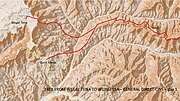
Adama, formerly Nazreth, is a one of the cities of Oromia Region of Ethiopia. Located in the East Shewa Zone 99 km (62 mi) southeast of the capital, Addis Ababa, the city sits between the base of an escarpment to the west, and the Great Rift Valley to the east.

The Awash is a major river of Ethiopia. Its course is entirely contained within the boundaries of Ethiopia and empties into a chain of interconnected lakes that begin with Lake Gargori and end with Lake Abbe on the border with Djibouti, some 100 kilometres from the head of the Gulf of Tadjoura. It is the principal stream of an endorheic drainage basin covering parts of the Amhara, Oromia and Somali Regions, as well as the southern half of the Afar Region.
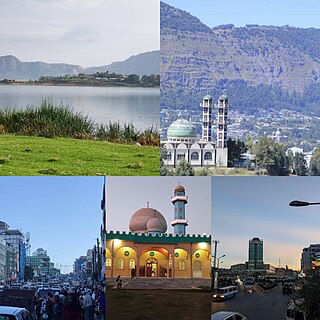
Dessie is a town in north-central Ethiopia. Located in the South Wollo Zone of the Amhara Region, it sits at a latitude and longitude of 11°8′N39°38′E, with an elevation between 2,470 and 2,550 metres above sea level. Dessie is 400 km to the north of the capital Addis Ababa. It has a population of more than 200,000 people in over 30 wards.

North Wollo also called Semien Wollo, is a zone in Amhara Region of Ethiopia. It is bordered on the south by South Wollo, on the west by South Gondar, on the north by Wag Hemra, on the northeast by Tigray Region, and on the east by Afar Region; part of its southern border is defined by the Mille River. Its highest point is Mount Abuna Yosef. Its towns include Lasta Lalibela and Weldiya. North Wollo acquired its name from the former province of Wollo.
Gidan is a woreda in the Amhara Region of Ethiopia. Part of the Semien Wollo Zone, Gidan is bordered on the south by Guba Lafto, on the southwest by Meket, on the west by Lasta, on the north by the Tigray Region, and on the east by Kobo. The administrative center of the woreda is Muja town, another small towns in Gidan include Debre Tsehay, Densa, Bekilo Mneqia, Iyella, Dildiy, Asikit, and Wonday.
Dawuntna Delant was one of the 105 woredas in the Amhara Region of Ethiopia. Part of the Semien Wollo Zone, Dawuntna Delant was bordered on the south by the Checheho River which separated it from the Debub Wollo Zone, on the west by the Debub Gondar Zone, on the north by Wadla, and on the east by Guba Lafto. The deep valley of the Zhit'a river, which runs through Wadla and along part of the northern border, effectively isolates much of Dawuntna Delant from the rest of Semien Wollo. This woreda was named after two historical districts, Dawunt to the east and Delanta to the west. The major town in Dawuntna Delant was Wegeltena. This woreda was separated for Dawunt and Delanta woredas.
Guba Lafto is one of the woredas in the Amhara Region of Ethiopia. Part of the Semien Wollo Zone, Guba Lafto is bordered on the south by the Debub Wollo Zone, on the west by Delanta and Wadla, on the northwest by Meket, on the north by Gidan, on the northeast by the Logiya River which separates it from Kobo, and on the southeast by Habru. Weldiya is an enclave inside this woreda. Towns in this woreda include Hara.
Habru is a woreda in the Amhara Region of Ethiopia. Part of the Semien Wollo Zone, Habru is bordered on the south by the Mille River which separates it from the Debub Wollo Zone, on the west by Guba Lafto, on the north by the Alewuha River which separates it from Kobo, and on the east by the Afar Region. Towns in Habru include Mersa and Wurgessa.

Alamata is a town in the Tigray Region of Ethiopia. Located in the Debubawi (Southern) zone of Tigray it has a latitude and longitude of 12°25′N39°33′E and an elevation of 1,520 metres (4,990 ft) above sea level and is located along Ethiopian Highway 2. It is surrounded by Alamata woreda.
The Logiya, or Logia, is a river of east-central Ethiopia, a left tributary of the Awash River.
Delanta is one of the woredas in the Amhara Region of Ethiopia. Part of the South Wollo Zone, Delanta is bordered on the south by the Bashilo River which separated it from the Debub Wollo Zone, on the west by the Dawunt, on the northwest by Wadla, and on the northeast and east by Guba Lafto. The major town is Wegeltena, which is 98 kilometers away from the zonal capital Dessie and 499 kilometers from the nation’s capital Addis Ababa.

The Awash–Weldiya Railway is a standard gauge railway under construction, that will serve as a northward extension of the new Ethiopian National Railway Network.
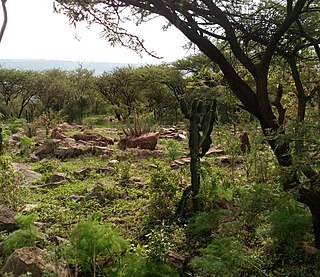
Addi Azmera is a tabia or municipality in the Dogu'a Tembien district of the Tigray Region of Ethiopia. The name refers to good spring rains (“azmera”), in relation to the local microclimate. The tabia centre is in Tukhul town, located approximately half-way between the woreda town Hagere Selam and the regional capital Mekelle.

Emni Ankelalu is a tabia or municipality in the Dogu'a Tembien district of the Tigray Region of Ethiopia. The tabia centre is in Mitslal Afras village, located approximately 20 km to the east of the woreda town Hagere Selam.

Addilal is a tabia or municipality in the Dogu'a Tembien district of the Tigray Region of Ethiopia. The tabia centre is in Addilal village, located approximately 19 km (12 mi) to the east of the woreda town Hagere Selam.

Mahbere Sillasie is a tabia or municipality in the Dogu'a Tembien district of the Tigray Region of Ethiopia. The tabia centre is in Guderbo village, located approximately 2.5 km to the west-northwest of the woreda town Hagere Selam.

Mizane Birhan is a tabia or municipality in the Dogu'a Tembien district of the Tigray Region of Ethiopia. The tabia centre is in Ma’idi village, located approximately 13 km to the southeast of the woreda town Hagere Selam.
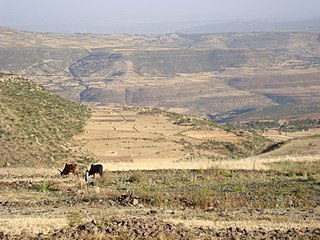
Ayninbirkekin is a tabia or municipality in the Dogu'a Tembien district of the Tigray Region of Ethiopia. Literal meaning of Ayninbirkekin in Tigrinya is "We will not bend". The tabia centre is in Halah village, located approximately 8 km to the east of the woreda town Hagere Selam. Main town is Ala'isa, situated on the ridge overseeing the Giba valley.
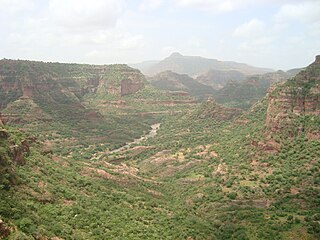
The Tsaliet is a river in northern Ethiopia, belonging to the Nile basin. Rising in the mountains of Dogu’a Tembien, where it is first called May Leiba River and then Tinsehe River, it flows westward through a deep gorge, to become Tsaliet in its lower course, where it empties in Weri’i River, just upstream of the main Weri’i bridge along the road to Adwa.
The A5 Road is a national route in Ethiopia. The highway runs for 608 kilometers from east to west. It starts off in Addis Ababa, which is the capital city of Ethiopian and it stretches towards south-western part of the country serving as an essential transport route for people, commodities and various services offered. Being one among others situated on Ethiopia's road network, A5 is one of the most important roads linking central highlands to the southern regions thereby contributing towards economic growth, trade between various regions without moving out of the country and enhancing social changes.









